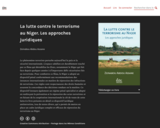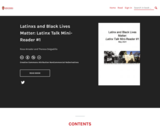
Infuse your course with immigration/multiculturalism OER activities.
- Subject:
- Arts and Humanities
- Social Science
- Sociology
- Material Type:
- Case Study
- Homework/Assignment
- Date Added:
- 06/30/2019

Infuse your course with immigration/multiculturalism OER activities.

Sociology is the study of social groups, structures, processes, institutions, and events. This course will focus on understanding and applying the sociological perspective, which stresses the importance of the impact of social forces external to the individual in shaping peopleęs lives and experiences. This idea that we are all profoundly affected by the society in which we live is the guiding light of sociology. Sociologists also study the ways in which people, as they interact, shape their social systems. Topics studied will include socialization, social interaction, culture, groups, social structure, deviance, social inequality, social class, race, gender, institutions (political, economic, educational, family, and religious), collective behavior and social change. Students will be asked to learn the basic concepts, theories, and perspectives of sociology, to see how these operate in terms of social processes, structures, and events, and to apply this knowledge to better understand the social world.

Focus Group Training

This learning video addresses a particular problem of selection bias, a statistical bias in which there is an error in choosing the individuals or groups to make broader inferences. Rather than delve into this broad topic via formal statistics, we investigate how it may appear in our everyday lives, sometimes distorting our perceptions of people, places and events, unless we are careful. When people are picked at random from two groups of different sizes, most of those selected usually come from the bigger group. That means we will hear more about the experience of the bigger group than that of the smaller one. This isn't always a bad thing, but it isn't always a good thing either. Because big groups ''speak louder,'' we have to be careful when we write mathematical formulas about what happened in the two groups. We think about this issue in this video, with examples that involve theaters, buses, and lemons. The prerequisite for this video lesson is a familiarity with algebra. It will take about one hour to complete, and the only materials needed are a blackboard and chalk.

This course is an introduction to Islam from the perspective of media and sound studies, intended for advanced undergraduates and graduate students. From the time of the Prophet Muhammad, Islam in its various manifestations has had a complex relationship with media. While much contemporary writing focuses on Islam in the media, this course explores how many aspects of Islamic practice and thinking might be understood as media technologies that facilitate the inscription, storage and transmission of knowledge. Central questions include: How do Islam and media technologies relate? What kinds of practices of inscription and transmission characterize Islam in all its varieties across time and place? How might Islamic thought and practice be understood in light of databases, networks, and audiovisual sensation? Given the rich diversity in Islam historically and geographically, emphasis will be placed on these interconnected but divergent practices from the earliest revelations of the Qur’an to contemporary Islamist political movements, with geographies spanning from Indonesia to the Middle East and North Africa, as well as in Europe and North America. In addition to exploring these themes through reading and writing, students will be encouraged to complete course assignments and projects in media, using audiovisual documentary or composition as a means of responding to the course themes.

This course aims to provide students with a general overview of basic themes and issues in Middle Eastern history from the rise of Islam to the present, with an emphasis on the encounters and exchanges between the “Middle East” (Southwest Asia and North Africa) and the “West” (Europe and the United States).

This subject investigates the special relation of women to several musical folk traditions in the British Isles and North America. Throughout, we will be examining the implications of gender in the creation, transmission, and performance of music. Because virtually all societies operate to some extent on a gendered division of labor (and of expressive roles) the music of these societies is marked by the gendering of musical repertoires, traditions of instrumentation, performance settings, and styles. This seminar will examine the gendered dimensions of the music - the song texts, the performance styles, processes of dissemination (collection, literary representation) and issues of historiography - with respect to selected traditions within the folk musics of North America and the British Isles, with the aim of analyzing the special contributions of women to these traditions. In addition to telling stories about women’s musical lives, and studying elements of female identity and subjectivity in song texts and music, we will investigate the ways in which women’s work and women’s cultural roles have affected the folk traditions of these several countries.

This course explores Japan’s role in world orders, past, present, and future. It focuses on Japanese conceptions of security; rearmament debates; the relationship of domestic politics to foreign policy; the impact of Japanese technological and economic transformation at home and abroad; alternative trade and security regimes; Japan’s response to 9/11; and relations with Asian neighbors, Russia, and the alliance with the United States.

This course is designed for students seeking a fundamental understanding of Japanese history, politics, culture, and the economy. “Raw Fish 101” (as it is often labeled) combines lectures, seminar discussion, small-team case studies, and Web page construction exercises, all designed to shed light on contemporary Japan.

This course covers medieval Japanese society and culture from the twelfth to the nineteenth centuries, when political power rested largely in the hands of feudal warriors. Topics include religion (especially Zen Buddhism); changing concepts of “the way of the warrior;” women under feudalism; popular culture; and protest and rebellion. Presentations include weekly feature films. Assigned readings include many literary writings in translation.

Long Description:
A core introductory sociology textbook that solves the three most common obstacles that both students and instructors struggle with: Students Do Not Read the Book: In an entertaining contrast to a typical “boring” textbook, this text is written in a storytelling style of narrative prose that injects irony and humor to engage students that they enjoy: “I really loved reading the chapter. I am not a reader, but I did continue reading the whole thing.” “It felt like a friend talking to me. I love how the book is being narrated.” “This did not seem like I am reading a book, it was like someone is telling me a story about what sociology is.” “And most of the sentences were friendly talking to me, not letting me read the whole chapter alone.”
By increasing the readability of the text, students come to class more prepared, and instructors can spend more time exploring the content with students rather than explaining the content. Students Do Not Understand the Book: The book is intentionally crafted around universal design principles. Universal design benefits everyone as it removes the need for accommodation and, thus, additional time from instructors. The textbook is globally accessible to allstudents regardless of their cultural background or diversity of ability. This non-Eurocentric core textbook dramatically reduces the confusion and burdens on students and instructors compared to a country or culturally-specific book. This is done by removing the barrier of “Cultural Overtime.” It refers to the additional work international students must perform to acquire the same cultural background information that domestic students already have the privilege of being socialized in. Lastly, because of its simplified writing style using everyday terminology, it communicates sociological jargon so that it can be absorbed without students resorting to dictionaries, internet help, tutors, or instructors to grasp its meaning.
Students Do Not “Get” Sociology: The textbook (The Human-Shaped Structure: An Introduction to Sociology) brands the study of the discipline within the broader social sciences (that study, the larger human-shaped world) and seamlessly maps onto standard curricula in introductory sociology courses (e.g., SOCI 100). Throughout the book, students learn to think sociologically and understand their role and place within the human-shaped world.
Word Count: 39581
(Note: This resource's metadata has been created automatically by reformatting and/or combining the information that the author initially provided as part of a bulk import process.)

Do you know what your bank does with your money? What is the role of a bank in producing societal well-being?
This course looks into banks that operate differently, namely, “just banks" that use capital and finance as a tool to address social and ecological challenges.
This course is for anyone who wants to understand the unique role banks play as intermediaries in our economy and how they can leverage that position to produce positive social, environmental, and economic change.
Go to OCW’s Open Learning Library site for 11.405x: Just Money: Banking as if Society Mattered. The site is free to use, just like all OCW sites. You have the option to sign up and enroll in the course if you want to track your progress, or you can view and use all the materials without enrolling.

This course explores the ideal of social justice. What makes a society just? We will approach this question by studying three opposing theories of justice—utilitarianism, libertarianism, and egalitarian liberalism—each foundational to contemporary political thought and discourse.

Today we’ll continue to explore sociology’s founding theorists with a look at Karl Marx and his idea of historical materialism. We’ll discuss modes of production, their development, and how they fit into Marx’s overall theory of historical development, along with class struggle and revolution. We’ll also discuss how Marx’s ideas gave rise to Gramsci’s idea of hegemony, and to conflict theories more generally.

In the wake of Katrina the entire gulf coast is embroiled in a struggle over what constitutes “appropriate” rebuilding and redevelopment efforts. This practicum will engage students in a set of work groups designed to assist local community based institutions and people in shaping the policy and practices that will guide the redevelopment and rebuilding efforts in the city of New Orleans.

Le phénomène terroriste perturbe aujourd’hui la paix et la sécurité internationale. L’espace sahélien est durablement touché par ce fléau qui déstabilise les États, notamment le Niger qui fait face depuis quelques années à d’importants défis sécuritaires liés au terrorisme. Pour combattre ce fléau, le Niger a adopté un dispositif pénal conformément aux recommandations des instances internationales en matière de répression des infractions de terrorisme. Ces règles sont respectueuses des droits humains et assurent la concordance des décisions rendues en la matière. Ce dispositif instaure également un régime pénal spécialisé et adapté en renforçant la prévention et la répression des actes terroristes et en faisant de la coopération internationale la clé de voute de cette lutte.Ce livre présente en détail ce dispositif juridique antiterroriste, issu de textes divers, qui a permis de mettre en place un cadre juridique complet et efficace de répression du terrorisme au Niger.

Word Count: 25128
(Note: This resource's metadata has been created automatically by reformatting and/or combining the information that the author initially provided as part of a bulk import process.)

This course studies the interaction between law, courts, and social movements in shaping domestic and global public policy. Examines how groups mobilize to use law to affect change and why they succeed and fail. The class uses case studies to explore the interplay between law, social movements, and public policy in current areas such as gender, race, labor, trade, environment, and human rights. Finally, it introduces the theories of public policy, social movements, law and society, and transnational studies.

Law is a common and yet distinct aspect of everyday life in modern societies. This course examines the central features of law as a social institution and as a feature of popular culture. We will explore the nature of law as a set of social systems, central actors in the systems, legal reasoning, and the relationship of the legal form and reasoning to social change. The course emphasizes the relationship between the internal logic of legal devices and economic, political and social processes. Emphasis is placed upon developing a perspective which views law as a practical resource, a mechanism for handling the widest range of unspecified social issues, problems, and conflicts, and at the same time, as a set of shared representations and aspirations.
We will explore the range of experiences of law for its ministers (lawyers, judges, law enforcement agents and administrators) as well as for its supplicants (citizens, plaintiffs, defendants). We will examine how law is mobilized and deployed by professionals and ordinary citizens. We cannot cover all aspects of the legal system, nor focus on all the different actors. A set of topics has been selected to develop understanding of the situational and systemic demands within which actors in the legal system operate and perform their roles; at the same time, we will try to discover systematic patterns in the uses and consequences of law. Throughout the course there is concern for understanding what we mean by legality and the rule of law.

Through lectures, discussions, and class exercises, 15.322 analyzes the human processes underlying organizational behavior and change. The class makes students aware of the challenge of organizational change and equips them to better handle it. There are many psychological and sociological phenomena that regularly occur in organizations, though many of these forces are difficult to see. The aim is to increase the students’ understanding of these forces – in themselves and in others – so they become more visible and manageable. The prerequisite for this course is 15.321 Leading Organizations I.